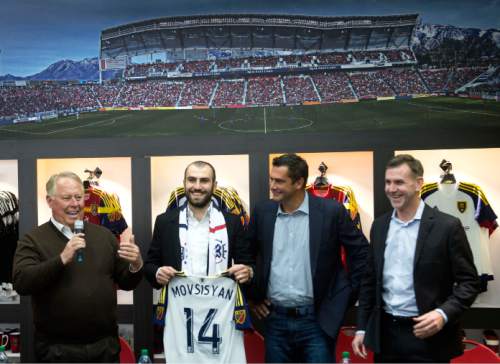This is an archived article that was published on sltrib.com in 2016, and information in the article may be outdated. It is provided only for personal research purposes and may not be reprinted.
Dell Loy Hansen is entering season No. 4 in his tenure as Real Salt Lake's primary owner. And much like in recent years, the ambitious mogul is preparing for the next phase of his plans to enhance RSL's overall brand.
After introducing new RSL striker Yura Movsisyan Tuesday afternoon in downtown Salt Lake City, Hansen spoke with the Tribune regarding plans to build a "world-class" soccer academy and training facility somewhere in the Salt Lake Valley. Hansen said RSL has spent the past six months preparing for an official announcement sometime in February.
This development comes after Hansen and RSL originally explored the possibility of building a soccer-specific stadium in West Valley City for the club's USL affiliate, Real Monarchs, which was estimated to cost over $20 million. The franchise and city officials entered into an exclusive 60-day negotiating window last March. However, Hansen said the team is setting aside the fully-designed stadium plans for a 6,000-seat venue, but after seeing the popularity in ticket sales of a few select Monarchs games in 2015 at Rio Tinto Stadium, his idea shifted toward building a training facility and academy.
Trey Fitz-Gerald, RSL's vice president of media & communications, said the club is eyeing "multiple sites" for the facility and academy, adding West Valley is one of those candidates.
Hansen said they've entertained the idea of relocating RSL's Arizona-based academy in Casa Grande, Ariz., in the process, but added no final decisions have been made. Fitz-Gerald said although facility details will be revealed in February, the academy would likely remain in Casa Grande on a full-time basis through the next two years.
"The goal would be that Arizona would still be a part of our territory, [director of soccer operations] Martin Vasquez and that staff that do such a great job down there," Fitz-Gerald said. "They would still be our guys, just everything would be more integrated."
An early target date is set for late 2017, he added.
"It's a large change, and it will actually mean we'll have to invest almost $15 million more than we planned on investing on the Monarchs stadium," Hansen said. "We'll make a larger investment, but it will be what the team needs, as opposed to as the stadium."
Asked if plans for the Monarchs stadium in West Valley have been abandoned, Hansen said the possibility remains. He again raised the possibility of a National Women's Soccer League (NWSL) franchise in Utah, as well as investments in rugby and lacrosse ventures. Hansen said in his discussions with West Valley officials, his dream is to one day build a stadium in the area. The design — which Hansen said RSL has spent $500,000 on thus far — is completed.
"There's a lot of reasons to spread the sport [of soccer] through the valley and use that [Monarchs] stadium, but it's better to invest our resources now in a first-class, I like to call it, 'The Harvard of training academies' is what we're going to present it as," he said.
Hansen also clarified his role in the restructuring of the RSL front office. After the contract of former team president Bill Manning expired last summer, Hansen assumed the role following Manning's departure. He will keep the role "for legal definitions" as club president, he said Tuesday.
"My goal is to be chief integrator," he said. "The role is to not carry out those functions as much as it's to make sure [the front office] works cooperatively together and spending more time on the growth. Right now, it's on the academies."
In 2015, Hansen spent upward of $3 million on a 4,200-square-foot video board on the south end of Rio Tinto Stadium. Later in October, the organization unveiled Utah's largest privately-owned solar array on the stadium's structure that offsets 73 percent of the club's total annual power needs at the stadium.
Twitter: @chriskamrani



